What is Radon?
It is a radioactive gas that has no color or smell and is formed from the decay of radioactive elements. It is usually found in soil and rocks and can move into the air and ground or surface water (“Radon” par. 1).
Susceptible Populations
- Underground miners. People working underground are exposed to high levels of radon and are highly susceptible to lung cancer risk;
- People working in uranium processing factories;
- People coming in contact with phosphate fertilizers (Kadi and Al-Eryani 225);
- Employees of water treatment plants (Juste et al. 497);
- People living or working in buildings built from radioactive materials;
- People living in buildings built on radioactive soil.
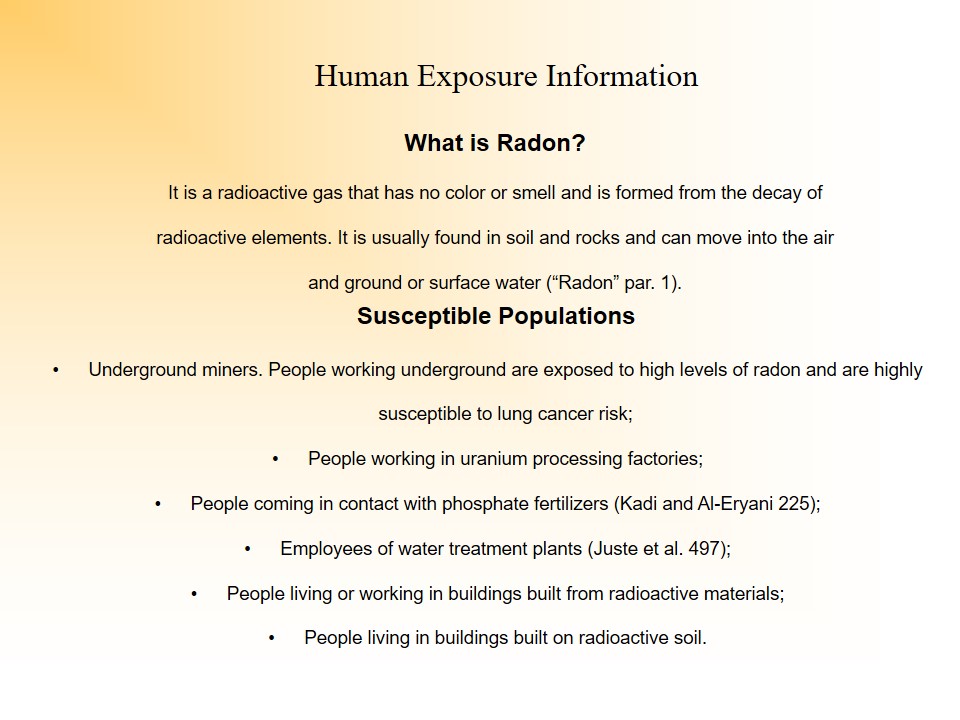
How People may Be Exposed
Houses built on the soil containing radon. After being released from soil and rocks, radon can enter houses through cracks in the floor, wires, pumps, etc. (“Radon” par. 5). The most significant way of the accumulation of radon in buildings is related to isolation of the gas from soil that serves as the basement of our houses. Radon is accumulated in tectonic cracks, where it is delivered from pinholes and micro-fissures of rocks. If the building is constructed over such zone, a flow of ground air with high concentration of radon enters it.
Radioactive building materials. Most natural building materials contain certain levels of radon. However, the levels of radon found in most building materials are low. The problem occurs if the materials do not go under appropriate sanitary and hygienic surveillance.
Water and natural gas. The highest risk of being exposed to high doses of radon is related to water vapor released while taking a shower. The concentration of radon in bathrooms is much higher than in other rooms. Natural gas also contains radon. If it is used for cooking, and the air funnel is not strong enough, the risk of being exposed to radon grows.

Dose-Response Information
People exposed to big doses of radon are susceptible to lung cancer. Radon exposure is a second most influential risk factor for lung cancer after smoking (Duana et al. 268). The risk of lung cancer may be controlled by assessing radon concentrations in Bq/m3 (“Current and Forthcoming ICRP Recommendations on Radon Exposure” 33).
The reference level of 300 Bq/m3 is equivalent to:
- – “17 mSv (12 mSv) for Homes”;
- – “8 mSv (5 mSv) for Workplaces” (“Current and Forthcoming ICRP Recommendations on Radon Exposure” 33).
Exposure to significant doses of radon in the houses increases the risk of lung cancer:
- The risk grows by “10% per 100 Bq/m3 increase”;
- “The risk significant for cumulative exposures – < 200 Bq/m3”;
- The risk for smokers is twenty-five times bigger than for non-smokers (“Current and Forthcoming ICRP Recommendations on Radon Exposure” 8).
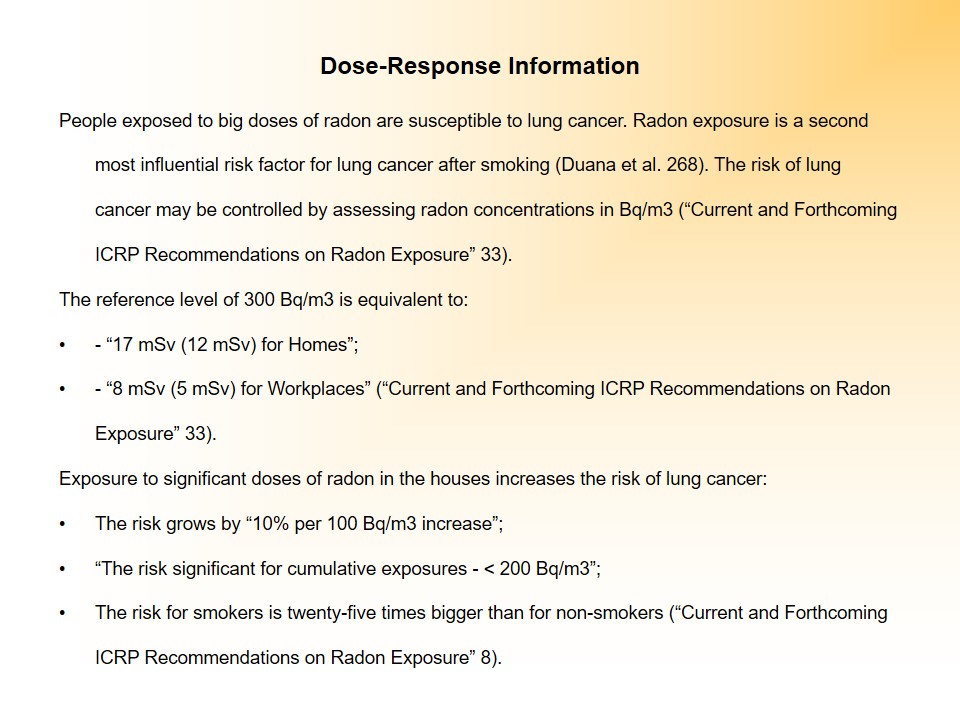
Monitoring
Monitoring the health status of the community exposed to elevated levels of radon should include individual monitoring for radiation status.
Individual monitoring involves:
- Body activity measurements;
- Excreta monitoring;
- Air sampling (carried out “”drawing air through the filter using a calibrated air pump”) (Martin and Sutton 126).
Further decisions related to monitoring the health status of the patients should be based on:
- The results gained at this stage of health assessment;
- The disposition of people experiencing radon exposure to lung cancer. Monitoring the health status of the members of the community exposed to big doses of radon should involve activities aimed at determining symptoms of this disease.
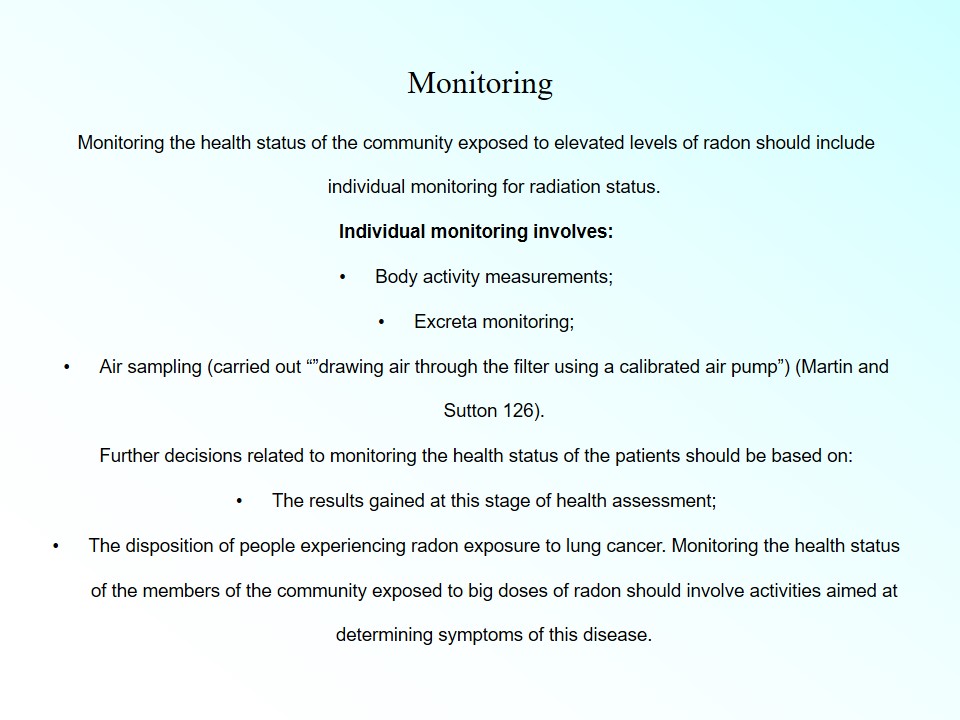
Further Actions
Further actions involved in monitoring health status of the community should include:
- Using questionnaires aimed at determining the prevalence of changes in the overall well-being of the members of the community that can be related to radon exposure;
- Conducting regular physical examination aimed at determining lung cancer symptoms;
- Conducting regular blood tests, including complete blood count (CBC) and basic metabolic panel (BMP);
- Conducting other clinical assessments designed to reveal certain indicators of developing lung cancer, including bronchoscopy;
- Paying special attention to smoking patients, as their susceptibility to developing lung cancer after being exposed to big doses of radon is higher than the susceptibility of non-smokers.
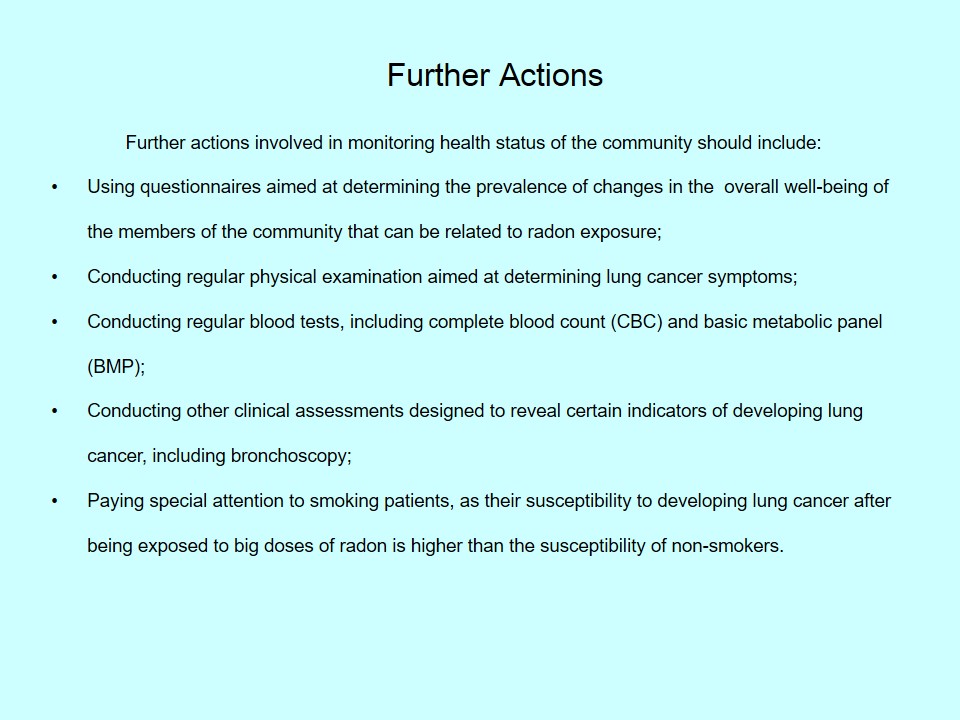
Evaluation
The solutions related to monitoring health status of the members of community should be evaluated based on:
- the ability of the chosen methods to provide timely effective diagnostic of diseases related to radon exposure (radon in particular)
- the efficacy of preventive actions.
The outcomes that should be measured include:
- the prevalence of lung cancer among the patients
- the stage of the development of disease at the moment of its detection.
The strengths of the approach include:
- Its orientation towards timely diagnosing of radiation status of the patients;
- Its orientation towards timely diagnosing of potential disease.
The limitations of the approach include:
- Its low ability to provide prevention of development of the disease;
- Its low ability to control the causes of potential disease.
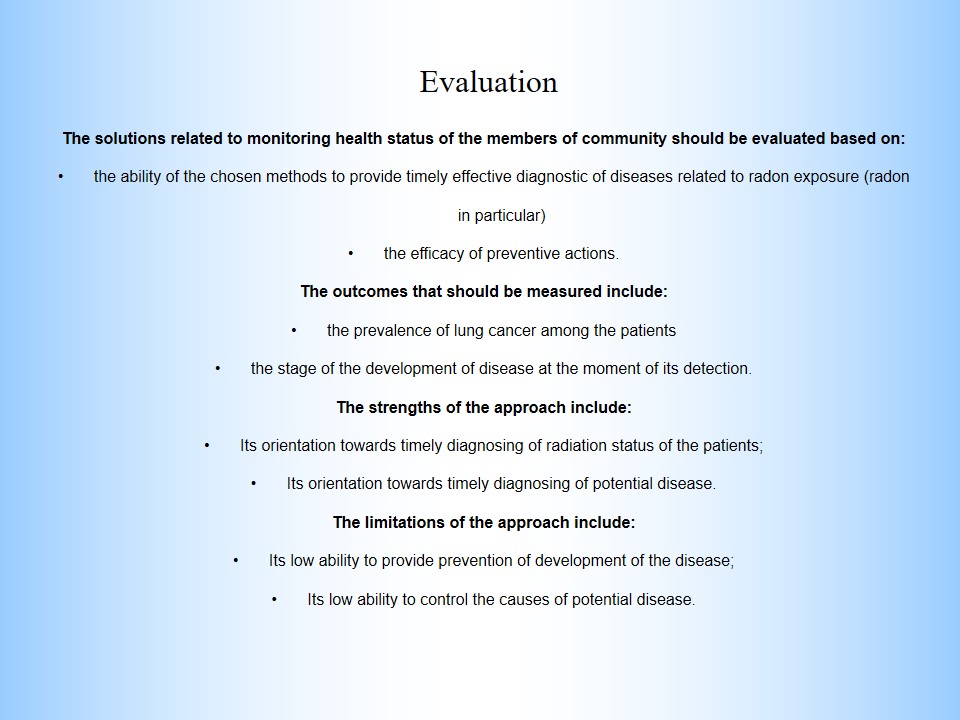
Works Cited
Current and Forthcoming ICRP Recommendations on Radon Exposure. 2014. PDF file. Web.
Duana, Peng, Chao Quana,Chunhui Hub, Jicai Zhangb, Fei Xieb, Xiuxue Hub, Zongtao Yub, Bo Gaob, Zhixiang Liub, Hong Zhengc, Changjiang Liua, Chengmin Wanga, Tingting Yua, Suqin Qia, Wenjuan Fua, Ansoumane Kouroumaa, and Kedi Yanga. “Nonlinear Dose–response Relationship between Radon Exposure and the Risk of Lung Cancer: Evidence from a Meta-analysis of Published Observational Studies.” European Journal of Cancer Prevention 24.4 (2015): 267-277. Print.
Juste, Bernardo, Josephina Ortiz, Gumersindo Verdu, and Simo Martorell. “Air Radon Concentration Decrease in a Waste Water Treatment Plant.” Radiation Protection Dosimetry 164.4 (2015): 497–501. Print.
Kadi, Mohammad, and Dheyab Al-Eryani. “Natural Radioactivity and Radon Exhalation in Phosphate Fertilizers.” Arabian Journal for Science and Engineering 37 (2012): 225-231. Print.
Martin, Colin, and David Sutton. Practical Radiation Protection in Healthcare. 2nd ed. 2015. New York: Oxford University Press. Print.
Radon. 2015. Web.